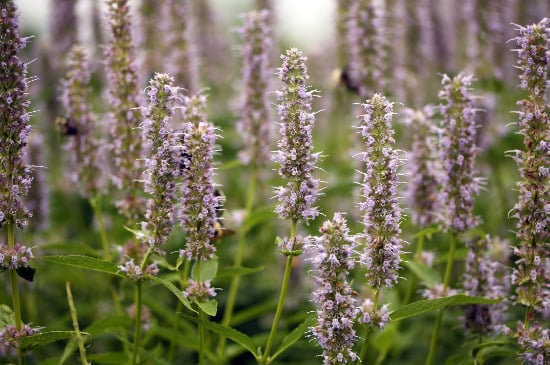Anise hyssop (Agastache foeniculum) is a beautiful plant, a perennial herb that is native to North America. It thrives in sunny locations and has long spikes of lavender-colored flowers that generally bloom June through September. It’s a member of the mint family.
There is a big patch in my garden. It has spread out a lot since I planted it two years ago because it grows in “clumps.” It is constantly buzzing with honeybees….
Anise hyssop is not only beautiful to look at (the cut flowers make any arrangement look better), but it is also edible. The flowers taste like very sweet licorice.
Anise Hyssop makes a delicious tea that is said to benefit digestion. Simple anise hyssop tea is made by letting 2 cups of boiled water steep with 2 tablespoons of bruised fresh leaves for about 5 minutes. Then, strain the tea and serve hot or cold.
Judith Benn Hurley suggests using the tea to poach peaches in her book The Good Herb: Recipes and Remedies from Nature. This is a great idea that I will definitely try.
The leaves can also be added to baked goods, including fruit tart and pie crusts. Add it to cookies, breads, or other baked goods that taste good with black licorice. Lemon pairs well with anise hyssop, so give this Lemony Anise Hyssop Tea Bread a try.
I recently discovered that anise hyssop leaves make a wonderful addition to salads. Yesterday, I combined some sauteed greens with cherry tomatoes, cooked fava beans, and naturally smoked mozzarella. I put some extra virgin olive oil and aged balsamic vinegar on top, and then I sprinkled chopped anise hyssop on top of that. Yum!.
Hurley says that anise hyssop is also very useful as a medicine. For example, the Cheyenne and Chippewa used the flowers and leaves to treat colds and coughs. I’m going to dry the leaves in a month or two and then store them in honey so I can use them to treat sickness this winter. This might work well instead of my Garlic Honey Sore Throat Remedy, which I really liked.
Hyssop is an aromatic herb that has been used for centuries for its medicinal properties. When brewed into a tea, hyssop has a pleasantly minty and slightly bitter taste that is great for soothing sore throats, easing anxiety, aiding digestion, and more. Read on to learn all about hyssop tea including how to make it, its benefits, and some delicious recipe ideas.
Hyssop (Hyssopus officinalis) is a perennial herb that belongs to the same family as mint, thyme, and lavender. It has small lance-shaped leaves and purple, pink, or white flowers that bloom in the summer. Due to its pleasant aroma, hyssop has traditionally been used to make soothing teas, perfumes, and even an alcoholic distilled beverage called hyssop liqueur.
While native to the Mediterranean and parts of Asia hyssop grows easily in home gardens across North America. The leaves and flowers can be harvested throughout the growing season and dried for tea-making all year long.
Benefits of Hyssop Tea
As both a comforting hot drink and a natural remedy hyssop tea offers many potential benefits
-
Soothes sore throats and coughs. The warmth and anti-inflammatory compounds help relieve throat pain and irritation.
-
Eases anxiety and promotes relaxation. Hyssop contains chemicals that may have mild sedative effects on the nervous system.
-
Improves digestion. Hyssop helps stimulate bile production and intestinal contractions to relieve indigestion, gas, and bloating.
-
Supports the immune system. Antioxidants in hyssop fight cell damage from free radicals and boost the body’s defenses.
-
Helps treat respiratory infections. In addition to soothing sore throats, hyssop’s antimicrobial action may fend off sinus infections, colds, and lung congestion.
-
Improves circulation and heart health. Hyssop tea contains chemicals that may help dilate blood vessels and lower blood pressure.
Of course, consult your doctor before using hyssop tea or any herbal remedy to treat health conditions. But a warm cup of hyssop tea can be a tasty way to promote overall wellness.
How to Make Hyssop Tea from Fresh or Dried Herb
One of the great things about hyssop is that it’s just as easy to make tea from the fresh or dried herb. Follow these simple steps for brewing hyssop tea:
Fresh Hyssop Tea
-
Harvest 6-8 stems of fresh hyssop leaves and/or flowers. Rinse gently under cool water.
-
Add the hyssop and 2 cups freshly boiled water to a teapot or French press.
-
Allow to steep for 5-7 minutes, then press the leaves before pouring into mugs.
Dried Hyssop Tea
-
Use 1-2 teaspoons of dried hyssop leaves and/or flowers per cup of tea.
-
Steep the dried hyssop in freshly boiled water for 7-10 minutes.
-
Strain the tea into mugs before drinking to remove any loose leaves.
Pro Tips:
-
Start with less hyssop until you determine your desired strength. Too much can make tea taste very bitter.
-
Try combining hyssop with other herbs like mint, lemon balm, chamomile, or lavender for more flavor complexity.
-
Sweeten with honey if desired, but avoid milk and cream as it can dull the flavor and health benefits.
Delicious Hyssop Tea Recipes to Try
One of the joys of herbal tea is experimenting with ingredient combinations to create delicious blends. Here are some tasty hyssop tea recipes to try:
Soothing Throat Tea
Combine hyssop, grated ginger, lemon juice, raw honey, and a pinch of cayenne pepper for an immunity-boosting tea that eases sore throats.
Digestive Hyssop Tea
Brew hyssop, fennel seeds, chamomile, and lemon verbena into a soothing digestive tonic. Sweeten with a touch of maple syrup.
Minty Hyssop Iced Tea
For an invigorating iced tea, steep hyssop and peppermint leaves then mix with lemon juice and stevia. Chill before serving over ice.
Apple-Cinnamon Hyssop
Add thin apple slices, a cinnamon stick, cloves, and cardamom pods along with hyssop for a fall flavored tea.
Lavender-Hyssop Tea
Blend hyssop leaves with dried culinary lavender buds and lemon zest strips for a floral, aromatic tea.
Moroccan Mint Hyssop Tea
Steep hyssop, spearmint, and green tea with orange blossom water and raw sugar for a refreshing North African-style tea.
The options for delicious and healthy hyssop tea blends are endless. Part of the joy is experimenting with your own signature recipes!
Tips for Growing, Harvesting, and Preserving Hyssop
One of the easiest kitchen herbs to grow, hyssop thrives in a sunny spot with well-drained soil. Here are some useful tips for cultivating your own fresh hyssop:
-
Start hyssop from seed in the spring, or buy starter plants to transplant after the last frost.
-
Space plants 18-24 inches apart. They reach 1-2 feet tall and wide at maturity.
-
Harvest hyssop leaves as needed once plants are established. Cut back stems by half after initial flowering to encourage a bushier habit.
-
Cut hyssop stems just above a set of leaves. This promotes regrowth for continuous harvesting all season.
-
Gather flowers when fully open for best flavor.Dry leaves and flowers out of direct sunlight. Crumble and store in airtight containers.
-
To retain color and aroma, freeze extra fresh hyssop in ice cube trays with a bit of water.
With just a small garden bed or container, you can have enough hyssop to enjoy fresh tea anytime. Preserving your harvest means you can brew soothing cups all year long.
Final Thoughts on Brewing Hyssop Tea
From treating sore throats to easing anxiety, hyssop tea is a comforting, healing drink to enjoy daily. With its refreshing minty-herbal taste and multitude of health benefits, homemade hyssop tea is sure to become a new favorite ritual
More Anise Hyssop Recipe Ideas

[AHAVA153] How to make a delicious cup of hyssop tea
How do you make hyssop tea?
To make hyssop tea, bring 8-12 ounces of water to a boil. Add 1 tablespoon of dried hyssop leaves to a tea infuser or teapot. Pour the water over the dried leaves. Allow the tea to steep for 10 minutes Add honey and a teaspoon of lemon juice for flavor..
Can one drink soursop tea as an antioxidant?
Soursop leaf tea contains several bioactive compounds that have antioxidant action and can help reduce oxidative stress as well as prevent the development of diseases.
What is hyssop tea?
Hyssop tea is a popular herbal tea that is made from the dried leaves and flowers of the hyssop plant. It has a unique flavor and is said to possess many health benefits. If you’re looking to make your own hyssop tea at home, there are a few things you should know. First, you’ll want to make sure you’re using the right type of hyssop.
How do you choose a Hyssop plant for tea?
Common Hyssop is an herbaceous plant with attractive, small purple and white flowers. It is native to Europe and western Asia, but can be found in many other parts of the world. When choosing a hyssop plant for tea, look for a plant that has thick, shiny leaves and strong stems. A healthy plant will also have a pleasant herbal scent.

